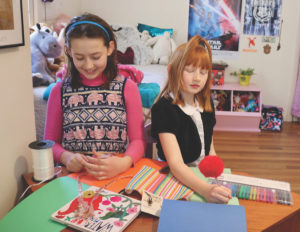Making a memory book is something like writing a memoir, but much more free-form. To make one, you gather stories and images that don’t have to fit together to recreate history. And you wrap them up in fun. Memory books capture moments or explore questions and can weave together words and art into whatever shape you decide to give them. As they say at school, they’re multidisciplinary. And to do them takes some time — something we are suddenly blessed with.

Young children and grownups can all get into this project, together or separately. When I was teaching, I did this activity with juniors in high school, and they loved it. Here, I’m adapting the activity to reflect the direction our daughters took with it this week. Cecilia and Lucy are 8 and 10 years old. They wanted to connect with their grandparents this way, and their themes had to do with happy times.
No matter the age of your memory book makers, you’ll want to start with a shared plan that reflects their interests. Then they can get going without the adults needing to hover.
Planning
Before you start, determine the basic organization of your memory book. Keep it to a manageable scope — we decided on four chapters. We thought about who the girls might interview, and decided the interviews would be a good opportunity to reach out to loved ones who are isolated now.
Your topics don’t have to be complicated. In our brainstorm, meals, work, hometown, holidays, and love were some things the girls were curious about. It’s good to have one child keep the list. Then each can choose favorites for the chapters they want to work on.
Here are some of the items on our list:
What was the most enjoyable meal you’ve ever had?
Tell me about the sports teams you cheered for as a kid.
What teacher most inspired you?
How did you meet Papa?
Interviewing
Talk about what makes for a good interview. You want to have your questions prepared, but there’s more to it than that. How might they encourage sidewinding stories? Who gets to go first asking questions? Who will take notes? Do the grandparents use Zoom or Google Hangouts, or just the phone?
Assembling the Book
The crafty part comes after the interviews are done. My kids are obsessed with binders, so I knew that a binder would be their format of choice. Use what you have on hand: construction paper, a notebook, printer paper. A cardboard box can be cut to form a good cover. Hunt in the yard and all over the house, raiding old craft boxes or toy chests for items that might be incorporated into the book.
The writing is the other main ingredient. One way to approach the writing is to have your children write their own answers to the interview questions, and write those alongside the family member’s. The responses appear on facing pages, creating two narrative voices that mirror each other, so your children see the similarities and differences between their own generation and another.
Have fun with this. Allow for errors. Let your kids’ writing have its own, only-in-this-moment voice.
It’s good to write the introduction last. We gathered around the table again to discuss it. What was it all about? Why did we create the book this way? We talked a little about this moment and the opportunity it offers for conversations with the ones we love. We picked one person to write the introduction.
Final Assembly
Now your memory book makers can dive into the pile of materials and really go to town. As they assemble, they might need to add extra pages for art. Your children might draw or paint a portrait of their subjects, create a mixed-media family tree, or put together collages of items like ticket stubs, hair ribbons, dried flowers, or buttons. If pictures are available, they can incorporate them. Here’s where you step back and get your own work done for a little while. If a hot glue gun is needed, step back in.
Publication
It’s time to reward everybody’s efforts and celebrate the family memories you’ve captured. Plan a reading of the book that fits your family’s style — in ours that involves an element of performance complete with a microphone and applause. They had fun sharing the finished work with their interview subjects, even though we had to do that virtually for now. We look forward to sharing the book in person later on.



